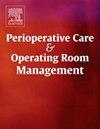Intraoperative opioid use is not a risk factor for postoperative nausea and vomiting in patients receiving intravenous patient-controlled analgesia with H1 antihistamines: a retrospective analysis
IF 1
Q2 Nursing
Perioperative Care and Operating Room Management
Pub Date : 2025-06-03
DOI:10.1016/j.pcorm.2025.100502
引用次数: 0
Abstract
Background
: Opioids are generally considered a risk factor for postoperative nausea and vomiting (PONV). However, our clinical experience suggests that intraoperative fentanyl and remifentanil dosages, as well as tramadol use, were not risks of PONV in patients receiving intravenous patient-controlled analgesia (IVPCA) containing fentanyl and an H1 antihistamine (PCA-H). Additionally, intraoperative use of an H1 antihistamine does not appear to reduce the incidence of PONV in patients receiving PCA-H. We hypothesized that neither opioid use nor intraoperative H1 antihistamine use would be associated with PONV in patients receiving PCA-H, and we investigated the incidence of and risk factors for PONV in these patients followng laparoscopic gynecological surgery.
Methods
: We examined the incidence of PONV in patients receiving PCA-H after laparoscopic gynecological surgery under general anesthesia. Patient characteristics, anesthetic factors, and intraoperative prophylactic antiemetics were analyzed through multiple logistic regression to assess their relationships with PONV.
Results
: A total of 1,778 patients were included, with 1,767 (99.4 %) receiving propofol-based anesthesia and 1,719 (96.7 %) received an intraoperative prophylactic antiemetic. Overall incidences of nausea, vomiting, and postoperative antiemetic use were 26.5 %, 8.7 %, 11.0 %, respectively. Intraoperative opioid use (fentanyl, remifentanil dose, or tramadol use) was not a risk factor for PONV. Additionally, intraoperative antihistamine use was ineffective.
Conclusion
: Intraoperative doses of fentanyl, remifentanil, and the tramadol use were not PONV risk factors in patients receiving PCA-H under propofol-based anesthesia. Concurrent use of an intraoperative antihistamine was not associated with a further reduction in PONV among patients receiving PCA-H.
术中使用阿片类药物并不是接受H1抗组胺药静脉自控镇痛的患者术后恶心呕吐的危险因素:一项回顾性分析
背景:阿片类药物通常被认为是术后恶心和呕吐(PONV)的危险因素。然而,我们的临床经验表明,术中芬太尼和瑞芬太尼的剂量以及曲马多的使用并不是接受含有芬太尼和H1抗组胺药(pca)的静脉自控镇痛(IVPCA)的患者发生PONV的风险。此外,术中使用H1抗组胺药似乎并不能降低接受PCA-H治疗的患者PONV的发生率。我们假设在接受PCA-H的患者中,阿片类药物的使用和术中H1抗组胺药的使用都不会与PONV相关,我们调查了腹腔镜妇科手术后这些患者PONV的发生率和危险因素。方法:观察全麻下腹腔镜妇科手术后行PCA-H患者PONV的发生率。通过多元logistic回归分析患者特征、麻醉因素、术中预防性止吐药物与PONV的关系。结果:共纳入1778例患者,其中1767例(99.4%)接受异丙酚麻醉,1719例(96.7%)接受术中预防性止吐药。恶心、呕吐和术后止吐药的总发生率分别为26.5%、8.7%和11.0%。术中使用阿片类药物(芬太尼、瑞芬太尼剂量或曲马多)不是PONV的危险因素。此外,术中使用抗组胺药无效。结论:术中芬太尼、瑞芬太尼和曲马多的使用剂量不是异丙酚麻醉下PCA-H患者PONV的危险因素。在接受PCA-H治疗的患者中,术中同时使用抗组胺药与进一步降低PONV无关。
本文章由计算机程序翻译,如有差异,请以英文原文为准。
求助全文
约1分钟内获得全文
求助全文
来源期刊

Perioperative Care and Operating Room Management
Nursing-Medical and Surgical Nursing
CiteScore
1.30
自引率
0.00%
发文量
52
审稿时长
56 days
期刊介绍:
The objective of this new online journal is to serve as a multidisciplinary, peer-reviewed source of information related to the administrative, economic, operational, safety, and quality aspects of the ambulatory and in-patient operating room and interventional procedural processes. The journal will provide high-quality information and research findings on operational and system-based approaches to ensure safe, coordinated, and high-value periprocedural care. With the current focus on value in health care it is essential that there is a venue for researchers to publish articles on quality improvement process initiatives, process flow modeling, information management, efficient design, cost improvement, use of novel technologies, and management.
 求助内容:
求助内容: 应助结果提醒方式:
应助结果提醒方式:


